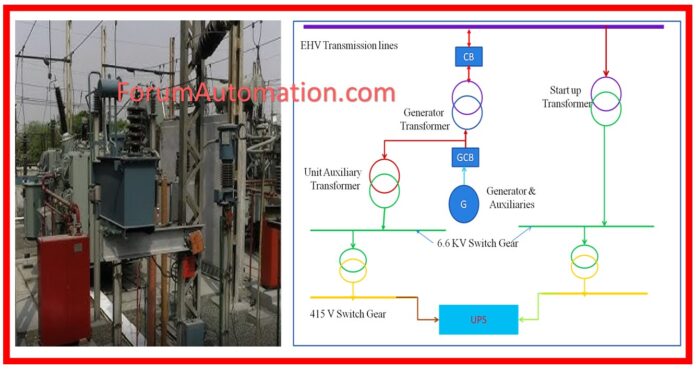What is an Auxiliary Transformer?
Auxiliary transformers are frequently found near the main power transformers. They are smaller & can withstand lesser power loads. They also help to maintain safety by isolating the main power supply from minor loads.
- An auxiliary transformer powers equipment in power plants.
- It supplies power to lights, control systems, & other tiny loads.
- These transformers are necessary for the proper operation of power plants.
Functions of Auxiliary Transformer
- Auxiliary transformers function as power control systems.
- Give lighting in power stations.
- Support small equipment.
- Ensure safety by separating the primary power.
Auxiliary Transformer Test Procedure
The Auxiliary Transformer Test describes several transformer testing processes, including:
- Measure insulating resistance to ensure proper configuration and record values.
- Performs turn ratio & magnetizing current tests with a test kit, injecting voltages and measuring ratios and currents at various tap points.
- Measure winding resistance by disconnecting circuits and discharging windings with a kit.
- Magnetic balance measurement involves applying voltages in sequence and measuring voltages to ensure primary and secondary winding balance.
Tests include:
1). Insulation Resistance Test
2). Ratio Test
3). Vector Group Test
4). Winding Resistance Test
5). Magnetizing Current Test
6). Magnetic Balance Test
1). Insulation Resistance Test
- To assess the insulation level of transformer windings and oil, this test is performed.
- Transmit the 5 KV on the primary to earth for 15 seconds and 60 seconds to determine the polarization index value.
- Distribute 2.5KV between primary and secondary, and record the 15 and 60 second values.
- Distribute 1 KV between secondary and earth and record the 15-second and 60-second values.
2). Ratio Test
- This test is used to identify transformation errors.
- Apply three-phase voltage to the primary side & measure the voltage of secondary side in TAPs 3 and 5.
- Determine the ratio error using the actual and measured values.
3). Vector Group Test
- This test is used to check the vector group given by the manufacturer.
- For example: Dyn11 Transformer.
- To validate, superimpose the 1R & 2R terminals & measure the voltages as per the following equation and justify.
Equation:
- 1R 1Y = 1R 2n + 1Y 2n
- 1Y 2B=1Y 2Y
- 1B 2B < 1B 2Y.
4). Magnetic Balance Test
This test is used to ensure that cores and phases are correctly identified, as well as to validate mutual flux inductance.
Apply voltage to one winding & measure the voltage sharing between the other windings.
In theory, the adjacent winding would have more flux than the other.
| Applied Voltage | Measured Voltage | ||||
| 1R -1Y | 1Y-1B | 1B-1R | 1R -1Y | 1Y-1B | 1B-1R |
| 415 | – | – | – | – | – |
| – | 415 | – | – | – | – |
| – | – | 415 | – | – | – |
5). Magnetizing Current Test
This test is conducted to determine the transformer’s no-load losses. Measure the magnetizing current of each winding/phase with a tong tester or multimeter and compare to the factory report.
6). Winding Resistance Test
This test is performed to verify the manufacturer’s declared resistance value and to assess any winding damage. Apply a DC current of 10 A through the winding, and the kit will calculate the winding resistance based on the voltage drop. Compare and verify the factory test report.









